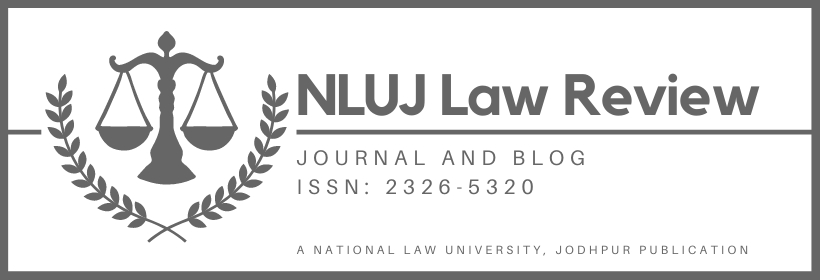The nearly uncontested oligopolistic dominance of companies Swiggy and Zomato in the food delivery sector has led to them being investigated by the Competition Commission of India for anti-competitive activities. After this paper explains the working of digital markets, it argues that this case provides the CCI with a unique two-fold opportunity. First, to bring the idea of collective dominance under the ambit of §4 of the Competition Act. Second, in pursuance of the first goal, to undertake the increasingly significant act of defining multi-sided markets for more holistic assessments of anti-competitive activity. These ideas are explored in this paper with reference to the present case.
I. Introduction
Alleging anti-competitive behaviour by food delivery giants Swiggy and Zomato (‘opposite parties/OPs’), the National Restaurant Association of India (‘NRAI’) filed a complaint with the Competition Commission of India (‘CCI’). Under § 3(4) read with § 3(1) of the Competition Act (‘the CA’), which deals with vertical anti-competitive restraints, there were primarily four allegations made by the NRAI. They were- that the opposite parties engaged in bundling of services, one-sided contracts, price parity, and lack of transparency in platform listing. The first two issues were held to be prima facie non-violative of the CA whereas, for the latter two, the CCI assumed violations and launched an investigation under § 3(4) and 3(1) of the CA.
It must be noted that the allegations made by the NRAI under § 4 of the CA which deals with abuse of dominant position were not addressed. This article intends to analyse the present case as an opportunity for the CCI to broaden its jurisprudence under § 4 of the CA. .
II. Navigating anti-trust law in the digital landscape – Understanding the Zomato-Swiggy Strategy
The last decade has witnessed a meteoric rise in the digital economy. The models that these businesses operate on are different from brick-and-mortar businesses, and anti-trust law needs to adapt accordingly.
To fully understand the nature of allegations put forth by the NRAI, the subsequent portion of the paper aims at understanding the mechanisms which digital markets operate on. These mechanisms are ubiquitous in the food delivery sector and are utilised by the OPs as well. Thus, the first subheading which subsequently follows discusses bundling of services while the second covers exclusive contracts.
A. Bundling of Services
The concerns raised by the NRAI, though legitimate, are classic features of a digital market. The OPs epitomise a ‘platform model’ – one where there are two or more sides, usually consumers and producers, are linked by an intermediary. A platform model in inherently different from a linear model insofar that it needs both producers and consumers to buy in to their product. Often explained as the ‘chicken and egg’ problem, this translates in the food delivery arena as Swiggy or Zomato having the simultaneous burden of ensuring that consumers order from them and also that restaurants keep supplying them with food. This is inherently different from a linear model such as television where supply only needs to be ensured from one end. A platform model creates unique competitive dynamics in what is described as the market ‘ecosystem’. On one hand, digital companies want to promote the inclusion of new third-party products on their platform to increase their attractiveness. Simultaneously, however, they need to leverage control over the third party to accrue profits. This manifests in digital markets, as correctly recognised by the NRAI, through bundling.
The OPs leverage control over third-party restaurants by bundling listing and delivery services together. To be listed on their platform, restaurants have to make use of the OP’s delivery partners and cannot self-deliver.
B. Exclusive Contracts
Consumer data is indispensable to the digital market. Accumulation of data helps in generating ‘network effects’ where an increase in users on one side leads to an increase in the number of users on the other, ultimately resulting in a rise in the value of the product. In the food delivery market, the two sides in question would be the restaurants that are listed on the food delivery application and the potential consumers who want to order food using the platform model. The more data that food delivery platforms accumulate, the more network effects they generate in their favour. These network effects form the biggest barriers to entry in digital markets. After accumulating a significant amount of big data, the incumbent platform assumes the role of a gatekeeper of the market. In the Matrimony.com v. Google case, the CCI recognised Google as a “gateway to the internet”, owing to its nearly unchallenged monopoly in the market.
The instant case sees the presence of two dominant entities instead of one, where they together occupy approximately ninety percent share of the food delivery market. This creates a scenario of ‘multi-homing’, i.e., when users liberally make use of two competing platforms at the same time. A prime example of this would be Uber and Ola. In the presence of an active competing platform, one tries to establish dominance by contractually requiring the restaurant to be listed exclusively on their platform. By doing this, the OPs create barriers for new entrants in the market by denying them access not only to restaurants but also to the consumers that come with it. Thus, a new platform, is compromised both at the supply (restaurant) and the demand (users who order food) ends. Players in the digital market sector are not rivals in the traditional sense but are often described as “frenemies.” They share co-dependent goals by not competing to get the same consumer base but offering exclusive benefits which neutralise the offerings of the rival platform.
The article henceforth aims to demonstrate how the CCI can use the present case to evolve as the competition watchdog now that we have a better understanding of the dynamics of the digital market.
III.A two-fold opportunity for the CCI
This portion of the paper will expand upon the opportunities which the present case presents to the CCI in terms of expanding its jurisprudence on digital markets. This opportunity is characterized as two-fold since it allows the CCI to first, recognise the concept of collective dominance. Additionally, as a statutory prerequisite to recognizing collective dominance, as will be discussed later, the CCI will also have to undertake the act of defining the market in which anti-competitive activity is alleged. Thus, section A of the subsequent portion focuses on collective dominance while section B focuses on delineation of the relevant market.
A. Collective Dominance
1. Understanding Collective Dominance
Oligopolistic markets are those where no single enterprise assumes a dominant position. This creates a scenario where two or more enterprises collectively exercise anti-competitive control over a market without necessarily entering into an explicit agreement to do so. This emerging concept in anti-trust literature is known as ‘collective dominance.’ The present case, representing a duopolistic market, is an example of this.
2. Indian Jurisprudence on Collective Dominance
The anti-trust jurisprudence in India does not recognise collective abuse of dominance by multiple parties. § 4 of the CA prohibits abuse of dominant position by an ‘enterprise or group’. Thus, this section penalises abuse of dominance by a single entity, precluding from its application cases of dominance by various enterprises together.
This has been explicitly stated in a catena of cases. In Delhi Vyapar Mahasangh v. Flipkart International Private Limited and Amazon Sellers Services Private Limited, the informant had alleged violation of § 4 of the CA due to Flipkart and Amazon’s abuse of their jointly dominant positions. As done by the NRAI in the present case, the individual and joint market shares of the two enterprises were used to establish their collective dominance. In response, the CCI rejected inquiry into these allegations since the concept of dominance by multiple enterprises is not “envisaged by the provisions of the Act.” This position was reaffirmed in the Ashok Kumar Vallabhaneni v. Geetha SP Entertainment LLP.
3. Rationalising the NRAI’s Approach
An interesting assertion has been made by the NRAI in their complaint. They allege a violation of both § 3(4) and 4 of the CA, but due to the non-establishment of the OPs as ‘dominant’ parties, limit their submissions to § 3(4). This is a well-calculated move, keeping in mind that the CCI does not recognise the concept of collective dominance. As correctly identified by the NRAI, the threshold for market power is less in § 3(4) as compared to § 4. Application of § 4 of the CA comes with the prerequisite of establishing the party in question as a ‘dominant’ party. In the present case, not individual but collective dominance of Swiggy and Zomato is being alleged. As has been established, Indian anti-trust law does not recognise the concept of collective dominance. Thus, even though § 4 would be more apt in this situation, the NRAI has kept its arguments limited to § 3(4) which deals with anti-competitive agreements.
The NRAI’s submissions under § 4 can be established as an in arguendo. They appear to be in cognisance of the fact that it was more likely to meet success by alleging violation under § 3 rather than § 4 of the CA. A similar approach was adopted in the Flipkart and Amazon case.
4. The Need to Recognise This Concept- A Glimmering Opportunity
India lags far behind international jurisprudence on this issue. In a liberal interpretation of Article 102 of the Treaty on the Functioning of the European Union (‘the TEFU’), in the Italian Glass Flat case, it was held that two independent economic entities can jointly hold a dominant position “vis a vis the other operators on that market.” Article 102 of the TEFU concerns abuse of a dominant position by “one or more undertakings” in the internal market of the EU. This position of law has been retained in a catena of cases in the EU. A parallel can be drawn between the present case and the Nestle case in the EU where a bid for acquisition was rejected on the ground that the three undertakings collectively would have had such control over the market that other players would have become inconsequential. The case investigated Nestle’s bid to acquire all shares of a French bottled water company Perrier, and its subsidies. The acquisition was disallowed on the ground that it would create a “duopolistic, dominant position” of Nestle and Banque Indosuez (another bottled water company) in the market. If permitted, the acquisition would have allowed the undertakings to raise prices as per their whims. Thus, the Nestle case recognised the concept of collective dominance and took active steps to prevent it from taking place. The OPs in the present case have also been notorious for an unchecked rise in prices, over and above the cost charged by the restaurants.
Moreover, § 5 of the CA regulates the creation of combinations by acquisitions, and extends this penalty to “one or more persons.” This provision penalises multiple entities who tacitly collude to gain control over an enterprise. If the CA recognises the ability of multiple companies to come together through combinations and jeopardise free competition, it only makes sense to also recognise the ability of these entities to collectively dominate a market. Thus, recognition of collective dominance, at the very least, will only uphold principles which the CA has already established.
By alleging violation of § 4 of the CA, the NRAI has presented the CCI with a prime opportunity to recognise collective dominance by the OPs.
Recognising collective dominance goes hand in hand with defining the market in which anti-competitive activity is alleged. The importance of these definitions, particularly in India, in anti-trust jurisprudence is discussed below.
B.Defining Multi-Sided Markets
A corollary benefit of recognising collective dominance is the chance to define the boundaries of the relevant digital market.
This is because defining the relevant market is a necessary prerequisite to the application of § 4 of the CA. Traditionally, to establish anti-competitive practice under § 4, a three-pronged approach is followed. First, defining the relevant market; second, examining whether an enterprise is in a dominant position in the identified market based on the specifications of § 19(4) and finally, determining whether the conduct of the enterprise amounts to abuse of dominance.
Non-application of § 4, as was done by the CCI in the present case, eliminates the need to define the relevant market. However, the CCI has previously dealt with cases with require it to define the relevant digital market before determining whether anti-competitive activities have taken place. Keeping this in mind, the subsequent portion of the paper concerns CCI’s approach in defining these multi-sided digital markets so far. The fallacies of these definitions and how the present case presents an opportunity to resolve those fallacies is then analysed at length.
1. The Approach to the Definition of Multi-sided Markets
The concept of one-sided and multi-sided markets has been gaining traction in competition law, particularly with respect to digital markets. Though there is no fixed yardstick to differentiate between the two, there are two features which distinguish a multi-sided market from a one-sided one. First, a multi-sided market should serve two distinct consumer groups, usually constituting different sides of the market. Second, multi-sided markets are characterised by the presence of indirect network effects. Most digital markets are multi-sided in nature insofar as they serve two distinct but interdependent consumer groups.
Food delivery applications serve two distinct sets of consumers (restaurants that pay a commission to be listed on the application, and the users which pay for the cost and delivery charges of the food). The multi-sided nature of the OPs was affirmed by the CCI.
The interdependence between two consumer groups stems from the concept of network effects which can be direct or indirect in nature. Direct network effects occur when an increase in the total number of users raises the value of the platform to existing users. For example, an increase in the number of one’s acquaintances on Instagram increases the value of the platform to the consumer. Indirect network effects, a typical feature of multi-sided platforms, are where one user group derives utility from the other. The OPs are examples of this model. The more restaurants they offer, the more attractive they are to their users and vice versa.
The OPs are also ‘transaction platforms’ since they take the form of intermediaries to enable transactions between the two consumer groups; their multi-sidedness thus being essential to their service. A leading scholar on the issue of defining multi-sided markets, Filistruchhi suggests defining transaction platforms as a single relevant market due to indirect network effects, which makes one side of the market inoperable in the absence of the other.
2. The CCI’s Assessment of These Markets So Far
Between 2014 and 2021, the CCI has dealt with 38 cases involving digital platforms, 35 of which involve allegations under § 4 of the CA, thus putting a requirement on the CCI to define the relevant market. In the analysis of the recent cases, there is an inconsistency in the approach adopted by the CCI. In FHRAI v. MakeMyTrip and Others, the definition of the market was made from the perspective of the side which filed the complaint. A more nuanced approach was taken in the Amazon case where the informant’s definition of Amazon’s market as “online fashion retail in India” was rejected in favour of “market for services provided by online platforms for selling fashion merchandise in India”. This was coupled with a pertinent observation by the CCI on the nature of Amazon as a facilitator of trade, thus exhibiting indirect network effects. The former definition fails to capture this unique position of Amazon as a middleman in the transaction. The latter definition accommodates Amazon’s multi-sidedness by rightly characterising it as an “online platform” which offers a “market for services.” Increasingly, the CCI has undertaken delineation of markets in such a manner as to capture their intricacies and increase the accuracy of anti-trust assessment. In a case concerning its privacy policy, Whatsapp was defined as “the market for Over-the-top (OTT) messaging apps through smartphones in India.” Particularly relevant to this case, in the Apple case, the CCI, drew a distinction between ‘single-brand’ markets and platform markets. Unlike ‘single-brand’ markets, platform markets simultaneously connect two or more sets of market participants. Thus, while the food delivery application for a particular restaurant is a ‘single-brand’ market, platforms such as Swiggy or Zomato where the application merely acts as the intermediary between the consumers and various restaurants is a platform market.
While in cases such as these the CCI has shown promise in adapting its approach to digital markets, its upkeep has not been done in subsequent cases. In a case concerning Swiggy itself, there was no definition provided by the CCI of its relevant market. This prevents the CCI from evolving its jurisprudence in line with countries such as the US and UK.
3. The Present Case as an Opportunity to Expand Jurisprudence
Due to the presence of indirect network effects, the probability of anti-competitive behaviour is amplified in multi-sided markets. This is partly because power distribution is asymmetric in such markets. One group might derive greater value from the presence of the other than vice versa. This explains why transaction platforms charge a fee from one side while letting the other avail their service for free. Applications such as Swiggy and Zomato don’t require the user to make a payment before using its services. However, for restaurants to be listed on these platforms, they have to pay a fee.
By bringing collective dominance under the ambit of § 4 of the CCA, the CCI has the opportunity to define these digital markets and increase the accuracy of anti-trust assessments. In the contemporary digital market, there are an overwhelming number of players offering services, each of which have their own nuances. Defining the relevant market allows the CCI to undertake microscopic assessment of the alleged anti-competitive activities of the market players. This approach provides for more accuracy in anti-trust assessments as compared to examining the dynamics of a large, complex, undefined digital marketspace.
The present case is an innately unique one since defining the relevant market here would entail not only clubbing two platforms but also accommodating multi-homing. Multi-homing in digital markets can be understood as the act of users using several competing platforms parallelly. In the food delivery market, this looks like a consumer having downloaded the applications of both Swiggy and Zomato and switching between them regularly. The determinant of which platform is finally used, ultimately depends on the restaurants listed on the platform and the potential discounts that they offer. Multi-homing tendencies of consumers are also relevant to the considerations of the definition of the market. This is because the possibility of one consumer regularly switching between two applications has the potential to blur the lines while calculating the market shares of the players.
IV. CONCLUSION
The digital market in India is increasingly oligopolistic in nature. Swiggy and Zomato in the food delivery sector, Blinkit and Instamart in the grocery delivery sector, Uber and Ola in the radio taxi service sector are a few examples of the same. Provisions recognising Collective dominance and accurately defining relevant markets are some avenues which can be adopted to encourage competition in oligopolistic markets. This will necessarily require the CCI to understand the nuances of digital markets and what their models intend to achieve. For example, while the applications ‘Bharat Pe’ and ‘Phone Pe’ might seem similar at first glance, the former exclusively caters to merchants while the second can be used by sellers and consumers both. Additionally, by taking the much-needed step of recognising collective dominance, India will accommodate the changes in its fastest-growing digital markets and catch up with international jurisprudence on this issue. Since the case against the OPs will now be referred to the Director General for further investigation, a world of opportunities can lie ahead for India’s future in the anti-competition sector.
This article is authored by Vadita Agarwal, a second-year student at the West Bengal National University of Juridical Sciences.



